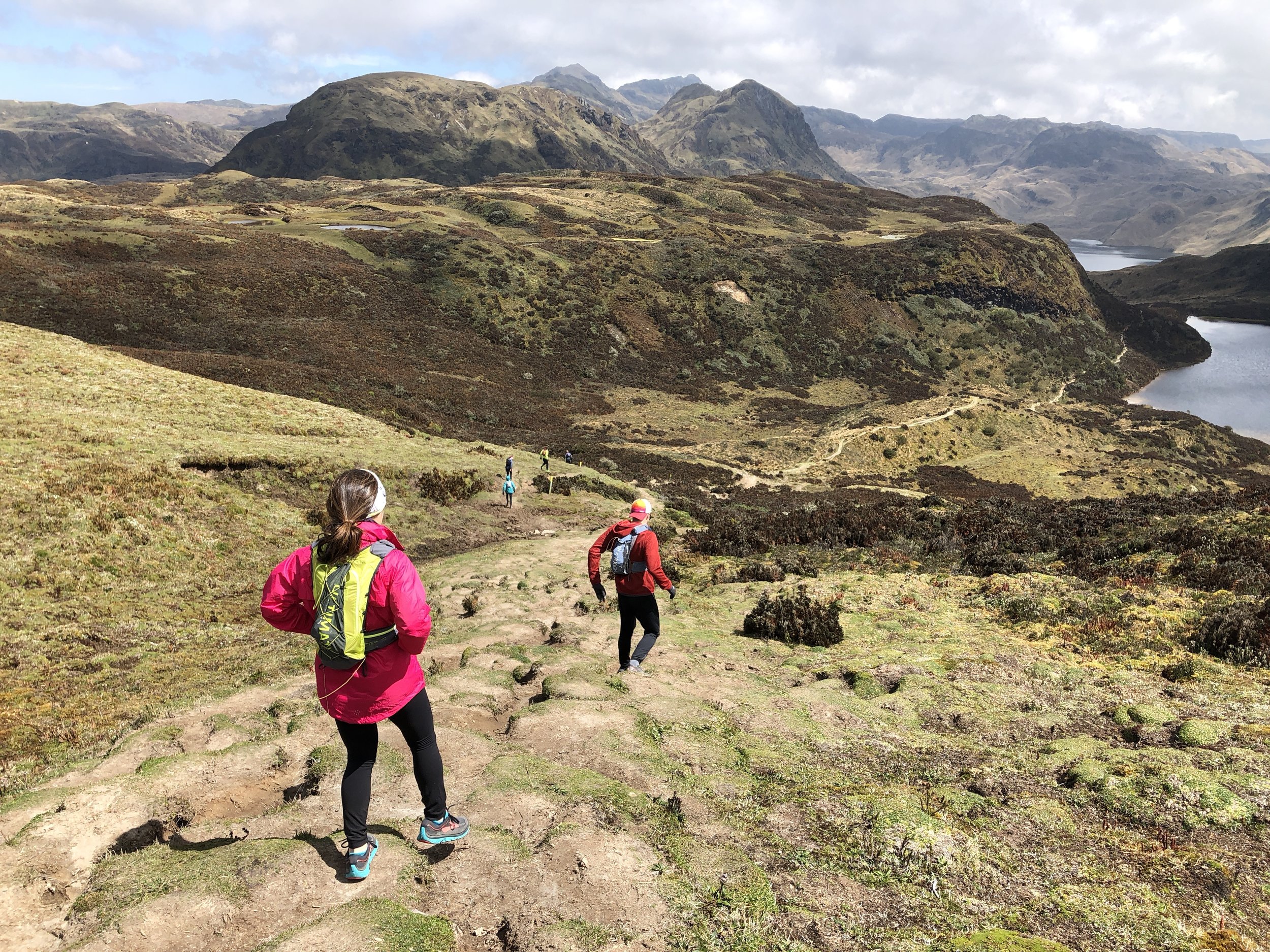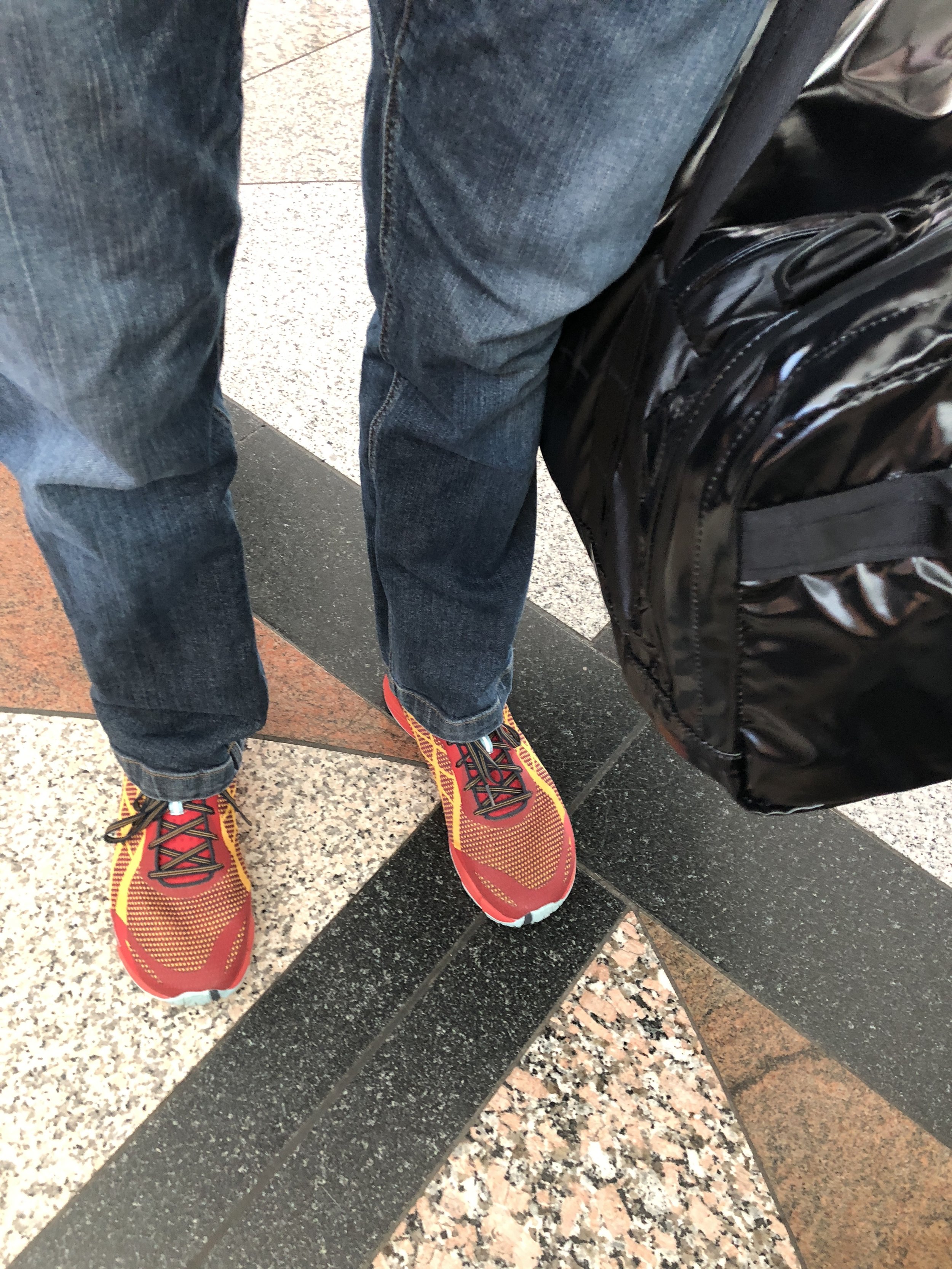Ecuador 2018 Part 2
/By Ashley Vander Meeden
Day 8 – Compared to our last peak hike, Fuya Fuya was a short and sweet 3-mile out and back. Not far from the town of Otavalo, this ancient volcano sits in the midst of three sparkling lakes and páramo grasslands. We started the hike at Mojanda Lake with clouds settled comfortably around the lake and mountain peaks. From the top, we were enveloped in clouds, blocking another spectacular view (we’d been pretty lucky on weather so we couldn’t really complain). As we started the downhill run, the clouds lifted to reveal the familiar combination of volcanoes, grasses, and lakes that never gets old. Hanging up our shoes for the day, we spent the afternoon immersed in the vibrant colors of alpaca-wool sweaters, scarves, textiles, blankets, and more in the Plaza de los Ponchos in Otavalo. We navigated the maze of vendors in the market, haggled politely, and eventually took home our treasures.
Day 9 – We started the day with a quick jaunt to the nearby waterfall Taxopamba. After giving our legs a little love, we jumped on the bus for over 5 hours to the Amazon. When we finally arrived, we immediately started peeling off layers. It was hot! We unloaded the bags, only so they could be loaded back onto giant motorized canoes, to travel from Punta Ahuano to the Anaconda Lodge. We arrived on the island, that is located between the Napo and Arajuno rivers, just in time to watch the sunset before dinner. Usually after dinner we talked about what our plans were for the next day and headed to bed early. This night we snagged our headlamps and long pants to head into the jungle for a night walk. We walked slowly along the path as every two seconds it seemed someone found a giant spider, bullet ant (giant ants with extremely potent stings, the highest level on the Schmidt pain index), or owl butterfly. As we inched along the path, our Kichwa guide, Cesar, disappeared down to the water’s edge. He emerged triumphantly with a baby caiman (small sized crocodilian) in his hands. From the small wood dock, we stood mesmerized as we scanned the water and gold eyes from caiman reflected back at us.
Day 10 – “Forward three” Paddle. Paddle. Paddle. “FORWARD!” On our guide’s command, we furiously paddled straight into a rapid. After over a week of tight lipped showers and bottled water for drinking and tooth brushing, the Rio Jatunyacu water slapped into our grins without mercy. This river, also known as The Upper Rio Napo or “Big Water” in Quichua, the indigenous language, is fed from the Cotopaxi Volcano and is exceptionally clean. We traded the trail for two rafts as we covered 25k on the water. We floated peacefully past vertical walls covered in orchids and the jungle rising all around us. Between tranquil sections of river, our ears were alerted to the alternating sounds of the distant rumble of upcoming rapids and the jarring loud motors of the illegal gold mining suction dredges. Halfway through the day we headed to shore to enjoy a delicious lunch prepared by our guides. Local Kichwa women from the “Shandia” community gathered to sell jewelry, purses, and other beautiful handmade items. We loaded our purchases in to dry bags and headed back to the water. We resumed the pattern of rapid then calm pool, over and over again. As we neared the town of Tena, a light drizzle coated are already soaked bodies. Many of us jumped in the water at this point, as we were already wet. Just as we were ending the day, the sky produced an enormous rainbow to cap off an epic day on the river in the Amazon.
Day 11 – Right after breakfast we headed back out into the jungle on our last day in the Amazon. The canoes took us past an island where capuchin monkeys swung in the trees. We floated silently below in the water as they playfully interacted with each other, completely ignorant of our presence. We continued on to an island with primary and secondary jungle. Veronica translated as our guide Cesar spoke to us about the trees and other plants in the jungle. We looked at trees that were used traditionally for shelter, basket weaving, roofing, and medicinal healing. After showers and lunch, we got on the bus to return to the Andes to the town of Papallacta and the magical resort of Termas Papallacta.
Day 12 – The last day was bittersweet. After short runs during our time in the Amazon, our legs were itching for some miles. Edwin drove the bus to 4300m (roughly 14,000′) in the Cayambe-Coca Ecological Reserve. As we bounced along the typical mountain road in anticipation of our last run of the trip, we were graced with the sight of a spectacled bear charging up and over a ridge in the distance. We stopped the bus and watched in awe. After continuing upward, we again caught sight of the beer as it ran down the other side of the mountain. At the end of the road, we unloaded the bus as the cold wind whipped us into action. The clouds threatened to obstruct the magnificent views of this day’s run, but the sky quickly cleared to reveal views of surrounding mountains, countless lakes at every turn, and the familiar páramo vegetation. We let our legs go as we flew downhill through yellows, greens, and reds. You would think after two weeks of spectacular views that we’d have already seen it all. The nearly 7.5 miles of our last run were just as breathtaking as the first 7 miles of the trip. Post run we headed back to the natural thermal pools to soak our muscles and soak up the last moments of our adventure.
We loaded the bus for the last time and headed back towards Quito. We spent the evening celebrating the trip at one more beautiful hotel, Casa d'Campo Tababela Hotel Boutique. The hotel is loaded from floor to ceiling, wall to wall, with an eclectic mix of art, and collectables. We let loose for one more time together as we sang embarrassing karaoke songs, played foosball and pool, and threw back a few celebratory drinks. We had covered Ecuador from the Andes to the Amazon and back again. Fueled by lots and lots of soup, good company, and our own two feet (well, most of the whole time).

















